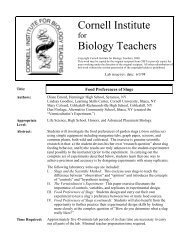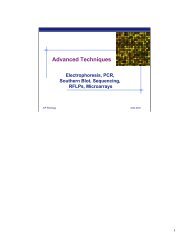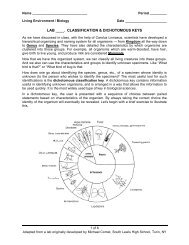open wide: decoding the secrets of venom - Explore Biology
open wide: decoding the secrets of venom - Explore Biology
open wide: decoding the secrets of venom - Explore Biology
You also want an ePaper? Increase the reach of your titles
YUMPU automatically turns print PDFs into web optimized ePapers that Google loves.
Name __________________________________<br />
<strong>Biology</strong><br />
As Dr. Fry reports in <strong>the</strong> March issue <strong>of</strong> Genome Research, <strong>the</strong> DNA <strong>of</strong> <strong>venom</strong> genes goes<br />
against this idea. He constructed evolutionary trees <strong>of</strong> 24 <strong>venom</strong> genes, searching through<br />
online databases for <strong>the</strong>ir closest relatives among non<strong>venom</strong> genes. In only two cases did he<br />
find that <strong>venom</strong> genes evolved from saliva genes. In almost all <strong>the</strong> o<strong>the</strong>r cases, <strong>venom</strong> genes<br />
evolved from ones that were active outside <strong>the</strong> <strong>venom</strong> gland — in <strong>the</strong> blood, for example, as<br />
well as <strong>the</strong> brain and liver.<br />
The evidence indicates that <strong>the</strong> evolution <strong>of</strong> a typical <strong>venom</strong> gene may begin with <strong>the</strong> accidental<br />
duplication <strong>of</strong> a gene that is active in ano<strong>the</strong>r organ. In a process known as gene recruitment,<br />
one <strong>of</strong> <strong>the</strong>se copies <strong>the</strong>n mutates in such a way that it begins producing proteins in <strong>the</strong> <strong>venom</strong><br />
gland.<br />
In some cases, <strong>the</strong>se borrowed proteins turn out to be harmful when injected into a snake's<br />
prey. Natural selection <strong>the</strong>n favors mutations that make <strong>the</strong>se proteins more lethal.<br />
"The snakes have harnessed <strong>the</strong>se proteins, changed <strong>the</strong>m and thrown <strong>the</strong>m right back at us,<br />
which is a pretty elegantly evil way <strong>of</strong> doing it," Dr. Fry said.<br />
Previous research on <strong>venom</strong> had <strong>of</strong>fered hints that some toxins might have evolved this way,<br />
but nothing more. For example, Dr. Elazar Kochva, a zoologist at Tel Aviv University, and his<br />
colleagues had noted some similarities between <strong>the</strong> <strong>venom</strong> <strong>of</strong> burrowing asps and certain<br />
enzymes in mammals. "We alluded to it, but Bryan Fry said it loud and clear and with a lot <strong>of</strong><br />
evidence," Dr. Kochva said.<br />
The concept <strong>of</strong> gene recruitment is not new, Dr. Rooney pointed out. Scientists have found<br />
evidence that it has played a role in <strong>the</strong> evolution <strong>of</strong> o<strong>the</strong>r organs, including <strong>the</strong> eye. "With<br />
<strong>venom</strong>, it seems to have occurred on a much grander scale," Dr. Rooney said.<br />
As new lineages <strong>of</strong> snakes evolved, <strong>the</strong>ir <strong>venom</strong> evolved as well. New genes were borrowed to<br />
produce new <strong>venom</strong>s, while existing <strong>venom</strong> genes duplicated many times, producing a huge<br />
diversity <strong>of</strong> molecules.<br />
This high-speed evolution allows snake <strong>venom</strong> to adapt to particular sorts <strong>of</strong> prey. Green<br />
mambas and black mambas, for example, are closely related species, but <strong>the</strong> green mambas<br />
live in trees while <strong>the</strong> black mambas live on <strong>the</strong> ground. "Not surprisingly, <strong>the</strong> black mamba<br />
<strong>venom</strong> is more potent against rats than against birds," Dr. Fry said, "while <strong>the</strong> green mamba<br />
<strong>venom</strong> is more potent to <strong>the</strong> birds than against rats."<br />
This rapid evolution has produced a wealth <strong>of</strong> complex molecules that researchers have barely<br />
begun to investigate. Evolutionary trees can serve as guides, speeding <strong>the</strong> search for new<br />
<strong>venom</strong>s and shedding light on how <strong>venom</strong>s work. "Just looking by chance is very difficult and<br />
not economical," Dr. Kochva said.<br />
The <strong>venom</strong> molecules that Dr. Fry has isolated from <strong>the</strong> inland taipan is a case in point. He has<br />
established that <strong>the</strong>y evolved from a family <strong>of</strong> proteins known as natriuretic peptides. In snakes,<br />
humans and o<strong>the</strong>r vertebrates, <strong>the</strong>se peptides relax <strong>the</strong> muscles around <strong>the</strong> heart.<br />
In <strong>the</strong> ancestors <strong>of</strong> <strong>the</strong> inland taipan, <strong>the</strong> genes for natriuretic peptides began producing <strong>the</strong>se<br />
proteins in <strong>the</strong> <strong>venom</strong> glands. Over time, <strong>the</strong>ir muscle-relaxing ability increased. Now <strong>the</strong>y can<br />
stop <strong>the</strong>ir prey's aorta from contracting at all.<br />
"They drop <strong>the</strong> blood pressure, which will knock <strong>the</strong> prey out," Dr. Fry said. "That gives <strong>the</strong><br />
slower, but more lethal toxins a chance to exert <strong>the</strong>ir effects." These slower toxins create<br />
swarms <strong>of</strong> clots in a prey's bloodstream, setting <strong>of</strong>f a vast number <strong>of</strong> strokes. "It's a good onetwo<br />
punch."<br />
3 <strong>of</strong> 5<br />
2004-2005

















